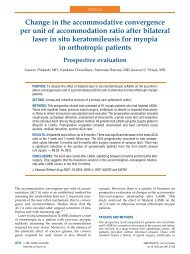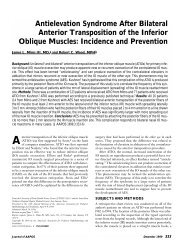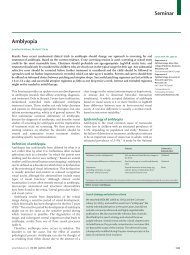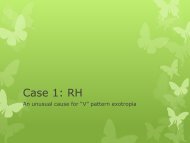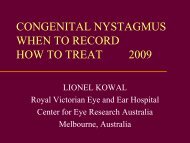What's new AAPOS 2008 - The Private Eye Clinic
What's new AAPOS 2008 - The Private Eye Clinic
What's new AAPOS 2008 - The Private Eye Clinic
Create successful ePaper yourself
Turn your PDF publications into a flip-book with our unique Google optimized e-Paper software.
RESULTS: Directly after birth, corneal diameter was 9.98 mm, increasing to a plateau of<br />
11.51 mm within the first 24 months of life. <strong>The</strong> coefficient of variation was 1.3%. Each<br />
measurement took no more than a few minutes.<br />
CONCLUSIONS: This method allows very precise, fast, noncontact measurements of<br />
corneal diameter in <strong>new</strong>born and young children.<br />
Bacterial keratitis after primary pediatric penetrating keratoplasty.<br />
Wagoner MD, Al-Ghamdi AH, Al-Rajhi AA.<br />
Am J Ophthalmol. 2007 Jun;143(6):1045-7.<br />
PURPOSE: To determine the prevalence, microbiological profile, and prognosis for<br />
bacterial keratitis after primary pediatric penetrating keratoplasty (PKP).<br />
METHODS: Retrospective review of all cases of primary PKP performed in children 12<br />
years of age or younger at the King Khaled <strong>Eye</strong> Specialist Hospital between January 1,<br />
1990 and December 31, 2005 and inclusion of all postoperative cases of culturepositive,<br />
bacterial keratitis.<br />
RESULTS: Culture-positive bacterial keratitis developed in 35 (17.3%) of 202 primary<br />
keratoplasties. Gram-positive organisms were cultured in 91.4% of infected eyes and<br />
accounted for 77.6% of isolates. Streptococcus pneumoniae was the most common<br />
organism. No eyes achieved a final visual acuity of 20/40 or better, while 65.7% had<br />
hand motions or worse.<br />
CONCLUSIONS: Bacterial keratitis after pediatric keratoplasty is a serious complication<br />
that is associated with a high risk of graft failure and poor visual outcome.<br />
Effect of Central Corneal Thickness and Radius of the Corneal Curvature on<br />
Intraocular Pressure Measured with the Tono-Pen and Noncontact Tonometer in<br />
Healthy Schoolchildren.<br />
JPOS 2007; 44:216-222.<br />
Central corneal thickness measurement has become increasingly important in the<br />
diagnosis and management of glaucoma. Most published studies of the effect of<br />
corneal thickness on IOP measurement have been based on the Goldman tonometer.<br />
<strong>The</strong> Tonopen and noncontact tonometer are currently in widespread clinical use,<br />
especially in pediatrics. IOP was measured in 602 eyes in 602 healthy Turkish<br />
schoolchildren. <strong>The</strong> Tonopen measured IOP values slightly higher than the noncontact<br />
tonometer. <strong>The</strong> IOP increased 2.1 and 4.2 mmHg with every 100-um increase in<br />
central corneal thickness for the Tono-Pen and the noncontact tonometer, respectively.<br />
<strong>The</strong> noncontact tonometer tended to overestimate IOP in eyes with thicker corneas.<br />
<strong>The</strong> corneal radius of curvature had no effect on measured IOP with either device. <strong>The</strong><br />
Tonopen is easy to use and less affected by corneal thickness and may be an<br />
alternative method for measuring IOP in children.<br />
43



